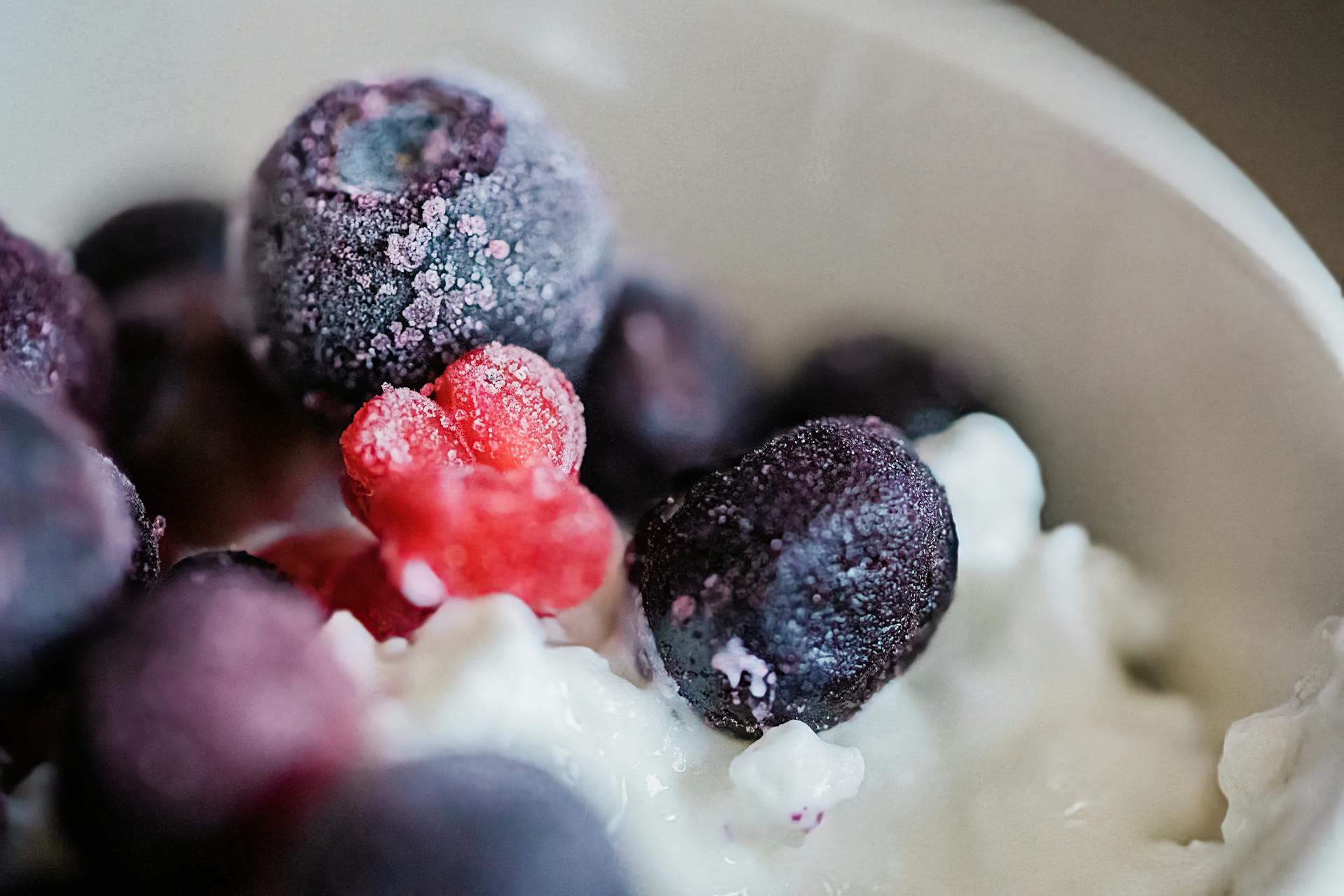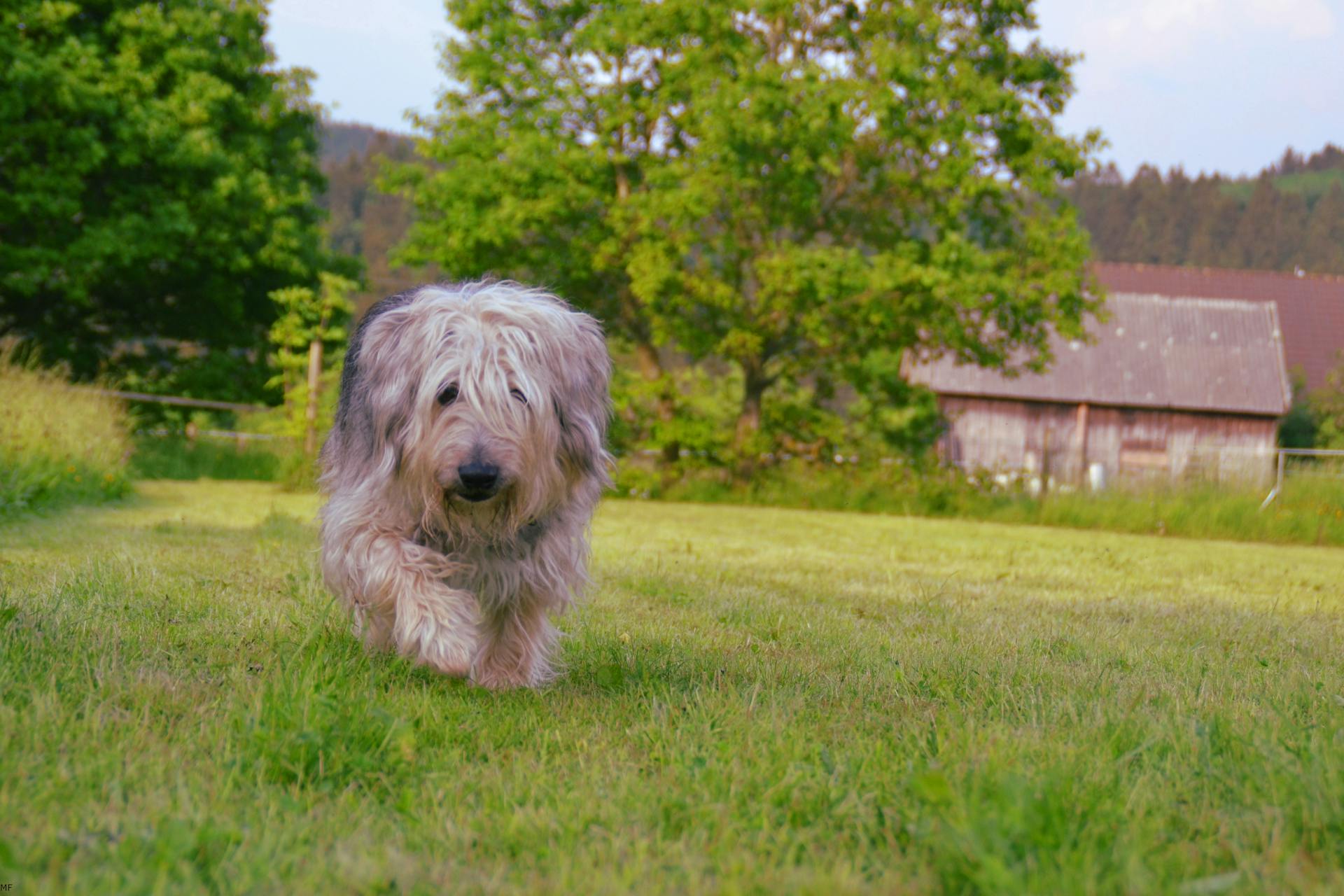
Frozen dog treats are a great way to keep your furry friend cool and happy during the hot summer months. They can be made with just a few simple ingredients like peanut butter and banana.
Peanut butter is a popular ingredient in frozen dog treats because it's a great source of protein and can be easily mixed with other ingredients. You can also use yogurt or pumpkin to add extra nutrition.
Frozen dog treats can be made in a variety of shapes and sizes, from small cubes to fun shapes like bones or even a dog's name. This makes them a fun and engaging way to keep your dog occupied and happy.
Making frozen dog treats at home is also a cost-effective option compared to buying them at a store.
Suggestion: Ingredients in Dog Treats
How to Make
Making frozen dog treats is a breeze, and you can customize them to your pup's tastes with just a few simple ingredients. You can use plain bone broth straight up or mix it with other dog-friendly liquids or purees for a special treat.
To get started, you'll need a few basic items: a bowl or container, a silicone mould or ice-cube tray, and a freezer. You can also use a blender or food processor to mix your ingredients, as seen in the recipe for blueberry frozen dog treats.
Mix all your ingredients together in a bowl until they're thoroughly combined. If you're using a thick-style yogurt, start with that and add the liquids incrementally for easier mixing. This is especially helpful if you're new to making frozen dog treats.
Once you've mixed your ingredients, pour or spoon them into your silicone mould or ice-cube tray. Make sure to fill the moulds or tray completely, as you can easily scale up or down the recipe to suit your needs.
Freeze the mixture thoroughly before removing it from the moulds. This will help prevent it from melting quickly, especially in warm temperatures. When you're ready to serve, transfer the frozen treats to a suitable container and return them to the freezer for storage.
Some tips to keep in mind when making frozen dog treats:
- Use natural ingredients and avoid artificial sweeteners like xylitol, which can be toxic to dogs.
- Experiment with different combinations of ingredients to find your pup's favorite flavors.
- Consider using coconut milk, pureed dog-friendly fruit or veggies, or other pet-safe ingredients as alternatives to dairy.
- Frozen dog treats can be messy, so it's best to serve them from a bowl or outside.
Here are some basic ingredients you can use to make frozen dog treats:
- Bone broth
- Yogurt
- Lactose-free milk
- Greek yogurt
- Blueberries
- Banana
- Coconut milk
- Pureed dog-friendly fruit or veggies
Remember to always check with your vet before introducing new foods or ingredients to your pup's diet, especially if they have special dietary requirements or allergies.
Ingredients and Equipment
To make frozen dog treats, you'll need to have the right ingredients and equipment on hand.
A blender or food processor is essential for mixing and pureeing the ingredients into a smooth consistency.
You can also use a variety of items to hold and shape the treats during freezing, such as ice cube trays, popsicle molds, paper cups, silicone molds, edible sticks, and popsicle sticks.
Related reading: Beef Sticks Dog Treats
Ingredients
When selecting ingredients for your dog's treats, it's essential to be mindful of what can harm them. Macadamia nuts, grapes, raisins, onions, and chocolate are all toxic to dogs.
Avoid using flavored yogurt, as it often contains artificial sweeteners that can be bad for your pup. Instead, opt for unsweetened plain Greek yogurt, or a lower-fat version if you're concerned about your dog's weight.
Frozen dog treats can be made with a variety of healthy ingredients, including yogurt, blueberries, and bananas. Fresh, freeze-dried, or frozen blueberries all work well in this recipe, but be sure to avoid dried blueberries with added sugar.
A ripe banana is all you need to add natural sweetness and texture to your dog's treats. Half a mashed banana is a great addition to any recipe.
You might enjoy: Banana Frozen Dog Treats
Equipment Needed
To make frozen treats for your dog, you'll need a blender or food processor to mix the ingredients.
A simple ice cube tray is a great option for holding and shaping the treats during freezing.
Popsicle molds are another great choice for creating fun shapes and sizes.
Paper cups can also be used to hold the treats, but be sure to remove the cup before serving to your dog.
Silicone molds are a popular choice for making frozen treats because they're easy to release the treats from.
Edible sticks and popsicle sticks can be used to make fun and easy-to-eat frozen treats.
Types of Frozen Dog Treats
Frozen dog treats are a great way to keep your furry friend cool and refreshed, especially during hot summer days.
You can make chicken or beef broth ice cubes, which provide a savory and flavorful treat for dogs.
Fruit-infused ice cubes are another option, made by adding small pieces of dog-safe fruits like apples, blueberries, or watermelon to ice cube trays.
Expand your knowledge: Puppy Dogs & Ice Cream
Peanut butter ice cubes are a hit with many dogs, made by mixing unsalted, unsweetened peanut butter with water and freezing it in ice cube trays.
Coconut water ice cubes are hydrating and can be a refreshing treat for dogs.
Meaty ice cubes can be made by freezing small pieces of cooked chicken, beef, or turkey in ice cube trays.
See what others are reading: Peanut Butter Dog Training Treats
Molds
For frozen dog treats, you'll want to choose the right mold to make the process easy and mess-free. I've found that silicone molds are the way to go, as they allow for easy removal of the treats without any fuss.
Silicone molds are a great option because they're oven and freezer safe, making them versatile and convenient to use.
If you're using a silicone mold, you can expect the treats to be very easy to remove, which is a big plus.
To ensure the right portion size for your dog, take into account their size when selecting a mold. You don't want the treat to be too large or small for their size, as this can lead to swallowing the treat whole. This isn't ideal, as it may come back up - trust me, it's not a pretty sight.
Explore further: Treat Right Dog Treats
Here are some mold options to consider based on your dog's size:
- Small molds for big dogs can be problematic, as the dog may swallow the treat whole.
- For large dogs, you can use a silicone baking cup, small paper cups, or muffin tin.
- When using a muffin tin, you may need to set it in a tray of warm water to loosen the treats.
Pupsicles on a Stick
Pupsicles on a stick are a fun and refreshing way to keep your furry friend cool on a hot summer day. They're easy to make and can be customized with your dog's favorite ingredients.
You can start by slicing some bananas and freezing them. Once frozen, mix the banana slices with some plain yogurt using a food processor. This will give you a smooth base with a milkshake-like texture.
Feel free to add other ingredients your dog will love, such as bacon bits or frozen strawberries and blueberries. Consider using a bone-shaped dog biscuit or any other stick-shaped, edible chew as a "stick" for your pup to hold onto.
Don't use real, wooden popsicle sticks, which might be a choking hazard for your dog. Instead, try dog-safe alternatives like bone-shaped dog biscuits, salmon skin treats, or bully sticks.
To release the pupsicles from the molds, let them sit at room temperature for a few minutes or run warm water over the mold for a few seconds. If you use paper cups, simply peel the paper off before serving.
Recommended read: Peanut Shaped Dog Treats
Benefits and Safety
Frozen dog treats can be a refreshing and enjoyable treat for dogs, especially during warmer weather.
They can help cool down your dog, providing some much-needed relief on hot days. Always check with your vet to make sure frozen treats are appropriate for your dog, especially if they have any dietary restrictions or health concerns.
Storage and Next Steps
Now that you've made a batch of delicious frozen dog treats, it's time to think about storage. You'll want to keep them fresh for as long as possible.
To store your homemade frozen dog treats, you can use a dog treat mold or an ice cube tray. This will help them retain their shape and make them easy to portion out.
Here are some storage options to consider:
- Dog treat mold
- Ice cube tray
Remember to label the container with the date you made the treats and what's inside, so you can easily keep track of how long they've been stored.
Frequently Asked Questions
What can you freeze in ice cube trays for dogs?
You can freeze chicken or beef broth, or fruit-infused water with dog-safe fruits like apples, blueberries, or watermelon, in ice cube trays for a tasty and refreshing treat.
What are the best frozen fruits for dogs?
For a cool and healthy treat, try using frozen bananas, strawberries, blueberries, watermelon, peaches, mango, pineapple, cranberries, or raspberries as a safe and tasty option for your furry friend.
What are cold dog treats for summer?
Cold dog treats for summer are frozen mixtures of plain yogurt and fresh fruit, such as cantaloupe, watermelon, and strawberries. These refreshing treats are perfect for hot summer days and are sure to be a hit with your furry friend!
Sources
- https://thekindpet.com/blogs/blog/5-diy-frozen-treats-for-dogs
- https://www.akc.org/expert-advice/nutrition/diy-frozen-dog-treats/
- https://www.barkingmad.uk.com/blog/dog-fun-facts/5-easy-frozen-dog-treats/
- https://www.peelwithzeal.com/web-stories/frozen-dog-treats/
- https://www.dalmatiandiy.com/recipe-bone-brothsicle-frozen-dog-treats/
Featured Images: pexels.com


